Chapter 2
An essential component to stress management is proper breathing technique.
In yoga this is known as pranayama (breath control), and is one of the eight limbs of the Yoga Sutras. When we are stressed out, angry, fearful or feel panicked, our breathing is immediately affected and usually entails shallow chest breathing (intercostal breathing). It‟s important that you become aware of your breathing patterns during states of tension and anxiety and identify what: “you are” feeling.
Am I angry?
Am I fearful?
Am I panicked?
By observing your breathing patterns during times of increased tension and anxiety, you‟ll be able to properly identify if your breathing is shallow and irregular. If it is, you will then shift into the relaxation response, by using proper breathing technique.
While there are many different breathing techniques used in yoga, our primary focus will be on “abdominal” breathing, which is synonymous with diaphragmatic breathing. Abdominal breathing will help you focus your attention, as well as bring calmness to agitated states. In short, it stimulates the parasympathetic nervous system and triggers the relaxation response.
Look for a flat area that is carpeted or you can use an exercise mat. Start by lying on your back with your hands falling to both sides with the palms facing upwards towards the ceiling. The legs are bent and the knees also point upwards. See following illustration.
9


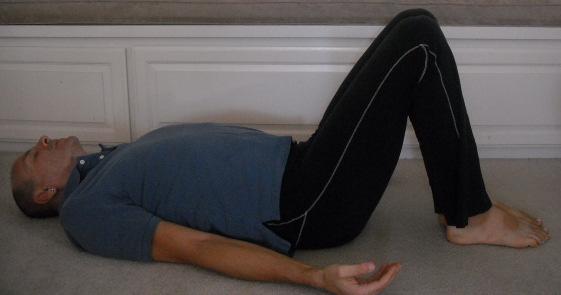
This posture is a modification of savasana (the resting pose) and it relieves tension in the lumbar region. Many clients I‟ve worked with that have stress related problems usually have lower back issues, so it‟s an excellent pose to adopt into your practice.
Focus on relaxing each part of your body while inhaling through the nose, as your belly rises, then exhale fully through the nose. Try to match your in-breaths and out-breaths so they are equal in length. You can start with 2 to 5
minutes of “abdominal” breathing and gradually build up to 10-15 minutes for deeper relaxation.
It is important to be conscious of your breathing and focus on taking in positive energy (as you inhale through the nose), and release negative tension (as you exhale through the nose). Try to scan each part of your body and identify where you‟re holding tension and let it go on the out-breath.
Ideally, the modified resting pose can be done in the morning and evening, (before bedtime). It can also be performed whenever you feel tense, or during an anxiety or panic attack. If you focus on deep free flowing breathing, it will usually stop the anxiety in its tracks.
10


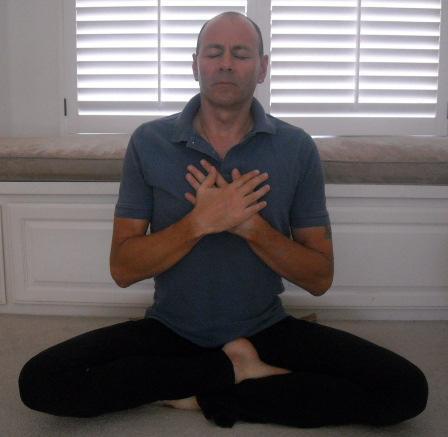
The next posture we will be utilizing for stress management is the “heart meditation” pose. It‟s simple to do and can be performed anywhere. It‟s also a powerful relaxation tool.
At the root of all anxiety is a focus of the heart. Often there are palpitations and a feeling of pressure in the heart region; yet, in most instances there is no physical underlying heart condition. This is because the heart chakra is out of balance, which goes back to the undigested experience and emotional trauma mentioned earlier. When we transform trauma through conscious breathing and relaxation, we are able to let go and be in the moment.
Sitting down on a cushion with your legs crossed (or in a chair with your back straight), place your left hand over your heart, then place your right hand over it. Close your eyes and take a deep inhalation through the nose, then exhale through your nose, while meditating on your heart center.
Imagine that each in-breath brings healing energy to the heart and emotions, while each out-breath releases your tension and anxiety.
Listen carefully to the sound of each breath like it‟s an ocean tide moving gently in and out. You should feel totally relaxed and renewed. Start with 2
to 5 minutes of deep breathing and gradually build up to 10-15 minutes.
11


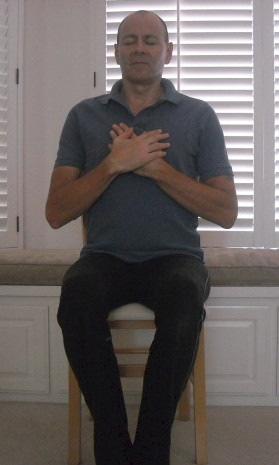
The heart meditation can also be performed while sitting in a chair or even while seated in parked car near the ocean or other natural scenery. It only takes five minutes to feel the benefits of this beneficial meditation pose, even with a hectic schedule.
It is normal when first practicing abdominal breathing to feel a little dizzy, since you‟re taking in more oxygen. In time, you‟ll come to appreciate the benefits of deep breathing, as you target more oxygenated blood to organs around the body. The rising and falling of the belly also gently massages the abdominal organs.
It is important that when you practice savasana (modified resting pose), or the heart meditation, that you remember the peaceful feeling it brings. The more your body becomes accustomed to this peaceful state, the easier it will be for you to recall it should you experience an anxiety or panic attack.
Gradually, with regular practice of Combat Yoga Fitness techniques, you‟ll be able to calm yourself, even in the midst of enormous tension and anxiety.
12


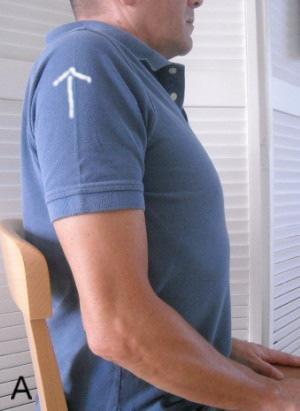
In addition to proper breathing, posture plays an important role in how we feel about ourselves. If your shoulders are slouched and you‟re hunched over, the chest won‟t be fully open and you won‟t be getting the benefit of deep breathing. The condition of thoracic kyphosis is common today, with so many people hunched over their computers and overall poor posture.
In yoga, there is a simple action to correct the problem of the shoulder slouch. Keeping you spine straight, you raise your shoulders up, back and down towards the spine. In doing this, the chest opens up and you can take in more oxygen and breath deeper.
Figure A above shows the shoulders raised up.
13


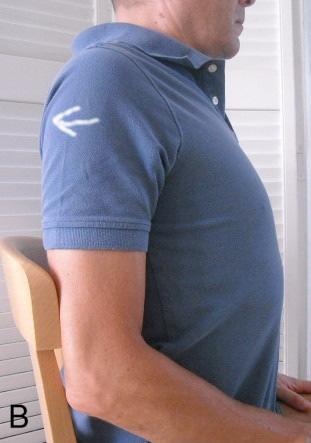
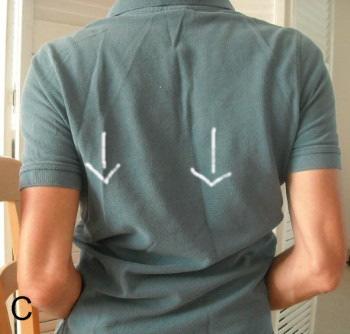
Figure B above shows the shoulders being drawn back.
Figure C shows the shoulder blades being drawn downwards towards the spine.
14


The corrective action of drawing the shoulders up, back and down towards the spine can be done while either standing or sitting. It‟s an integral part of yoga, along with standing and sitting tall. By being aware of your posture, you‟ll avoid falling into poor postural patterns, such as, slouching the shoulders and hunching over.
So, always stand and sit tall, as it will open up the chest and you‟ll be able to breath deeper and feel more alert.
In this program, we always breath in through the nose and exhale through the nose. The nose plays an important role in filtering the air we breath, as well as in our sense of smell. The olfactory system located in the nose is the sensory system that detects odors. Our nose also works in conjunction with the sinuses. There are four pairs of paranasal sinuses, the frontal sinuses are located above the eyes (in the forehead bone). The maxillary sinuses are located in the cheekbones (under the eyes). The ethmoid sinuses (between the eyes and nose). The sphenoid sinuses are located in the center of the skull (behind the nose and eyes).
When we breath in through the mouth, we are bypassing the important function that the nose plays. Moreover, stress from acute and chronic states of anxiety often affects the sinuses and allergies. One of the most important tools used to inhibit sinus congestion and allergens is a “saline sinus irrigation” system using warm water and rock salt (or sea salt). This simple method can be performed in the morning and in the evening.
In yoga, this sinus irrigation system is known as a netti pot. Quite simply put, it looks like a small tea pot and is filled with warm water (approx 8 oz), and 1/8 of a teaspoon of rock salt. The netti spout is inserted in one side of the nostril, while the side of the head is tilted causing the solution to flow out the other nostril. The process is then repeated for the other side.
15


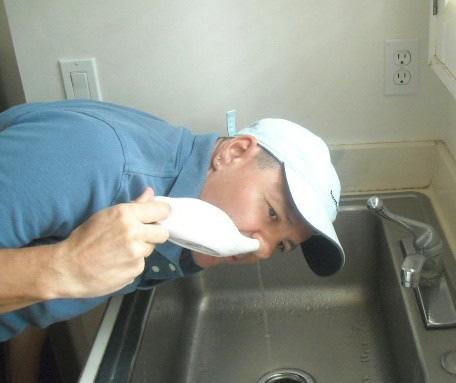
Basically, the flow of water through the nasal cavity creates a back pressure that opens up the sinuses. When the nose is stuffed up, it has a negative effect on overall health and emotions.
The following illustration shows how sinus irrigation is done. You can purchase a similar one at the local pharmacy.
Prepare the saline solution with warm water and fill the netti pot.
Tilt your head to the side as shown in the illustration.
Insert the spout gently into the raised nostril. Work at getting the water to flow out of the other nostril, while breathing through the mouth.
Raise the neti pot slowly to establish a steady flow of saline solution through the upper nostril and out the lower nostril.
When you're done, exhale firmly several times to clear the nasal passages or blow into a Kleenex.
Reverse the tilt of your head and repeat the process for the other nostril and side.
16


Troops serving in the military can especially benefit from using a sinus irrigation system. Given that many conflict areas are in remote and primitive settings, disease and airborne pathogens pose a serious risk. Hence, it‟s not unusual for military personnel in the field to develop respiratory problems leading to illness, in addition to allergies.
This is where the saline irrigation system shines, since it removes dust and allergens from the nasal cavity, while the salt content inhibits bacteria and viral activity. In those instances where there is a minor nasal infection, or sinusitis, antimicrobial herbs like goldenseal can be mixed into the saline solution and used to irrigate the nasal passages.
The active ingredient in goldenseal is the alkaloid “berberine”, which has shown activity against fungal infections, candida albicans, gram positive and negative bacteria and viruses.
One 500 mg capsule of goldenseal can be divided into two equal portions and placed in the netti pot corresponding to each side of the nose. This procedure can be used from three to five days until the sinus condition clears up. In some cases where the infection doesn„t clear up and there„s a fever, antibiotics and other treatment may be required.
Sinus irrigation plays an important role in keeping the sinuses and respiratory system healthy. It‟s especially useful for those operating in dusty, windy and arid regions, which is typical of desert terrain.
You can find goldenseal capsules at most health food stores, pharmacies and grocery chains. Netti pots are usually found in health food stores.
17


Sleep Hygiene. One of the biggest concerns for people suffering from tension and anxiety is interrupted sleep and feeling tired on waking up.
There are a number of things that can be implemented to ensure better Sleep:
Limit your coffee to two cups per day and avoid caffeine containing beverages.
Don‟t drink any alcohol for a minimum of three hours before bed.
Wind down during the second half of the evening and stop all work or other activities 90 minutes before bedtime.
Your bed should be comfortable and room temperature should be cool.
Keep sleeping area dark and control noise.
Stimulus Control.
Use you bed only for sleeping and sexual activity. Don‟t read or watch television in bed.
Turn the lights out immediately when you get into bed.
If your are aren‟t asleep within 20 minutes, get out of bed and sit and relax in another room, until you feel tired again. Repeat this step as often as necessary.
Sleep Restriction.
Set your alarm so you can get up at the same time every day, assuming you aren‟t working different shifts.
Try to avoid taking a daytime nap to compensate for a previous lack of sleep.
Follow the program rigidly for several weeks to establish a regular routine.
Music is also conducive to deep relaxation and sleep. There are many types of meditation albums specifically geared for relaxation. Classical music and smooth jazz both offer a mellow backdrop that can induce sleep.
18


Foot Care: Reflexology and Marma Pressure Points. One of the most important things for the infantryman operating in conflict areas is care of the feet. A sore and blistered foot makes it difficult to function effectively, even worse is a foot that has become infected.
Reflexology has been traced back thousands of years to the ancient Egyptians. In America, it was re-discovered by a physician by the name of William Fitzgerald, M.D., during the early 1900‟s. While observing patients receiving massages, he discovered that when pressure was applied to key points it caused numbness and improved the functions of organs in the body.
“Zone Theory” and many of his innovative ideas have been incorporated into modern reflexology.
Marma therapy, on the other hand, is a system of Indian marma points similar to acupressure and is mainly used in ayurvedic medicine. Ayurveda practices goes back to the ancient Vedic era and influenced the Chinese system of acupuncture and acupressure, which today is an integral part of Traditional Chinese Medicine (TCM).
We will be utilizing both reflexology and marma points to control anxiety and relieve stress. Simply put, you‟ll be learning to target these points, in order to alleviate your symptoms of stress and anxiety. When massaging and applying pressure to the foot, it‟s important to use a carrier massage oil that penetrates the skin. I find almond oil to be excellent for this purpose.
In addition, a few drops of lavender essential oil added to the almond oil carrier, is excellent for stress, since the aroma of lavender is known for its calming effects, and also has antimicrobial properties. In cases where there is foot fungas, a few drops of essential tea tree oil can be added to the carrier oil.
Many different types of carrier oils can be used. For example, in ayurveda, sesame oil is quite popular. So, don‟t feel limited with your choices of carrier oils in that regard. Olive oil, walnut oil, coconut oil are all suitable for reflexology and marma therapy.
19


To make your own massage oil, you‟ll add two to five drops of the essential oil, in this case either lavender or tea tree oil, to a 2 or 4 ounce container of almond oil. Keep in mind that essential oils are highly concentrated and can irritate the skin if not diluted. So, never use an essential oil on the skin in undiluted form!
Small plastic or glass containers are available in a variety of sizes, so it‟s a good idea to carry some pre-mixed massage oil with you (the carrier and essential oil). For military personnel operating in conflict areas where security poses a serious concern, it‟s recommended that only one boot be taken off at a time while working on the foot area with reflexology or using pressure points. A clean pair of socks should be used following inspection and maintenance of the feet.
One of the best ayurvedic oils for sore joints and feet is mahanayaran oil.
It is available at online stores that sell ayurvedic supplies. It‟s also good for sports related injuries, such as sprains and sore ligaments. It would make an excellent addition to the military kit.
For those of you not operating in conflict areas, the precaution of taking off only one boot off at a time need not apply. While yoga is usually performed barefoot, this program is also intended to be executed in remote regions, where troop security is of paramount importance. In those circumstances, this program will have to be modified to fit the situation at hand.
People that have served in conflict areas often remember the unpleasant smells associated with those areas. Using essential oils can offset this type of recollection by introducing pleasant aromas to stimulate the sense of smell, which forms the basis of aromatherapy.
20


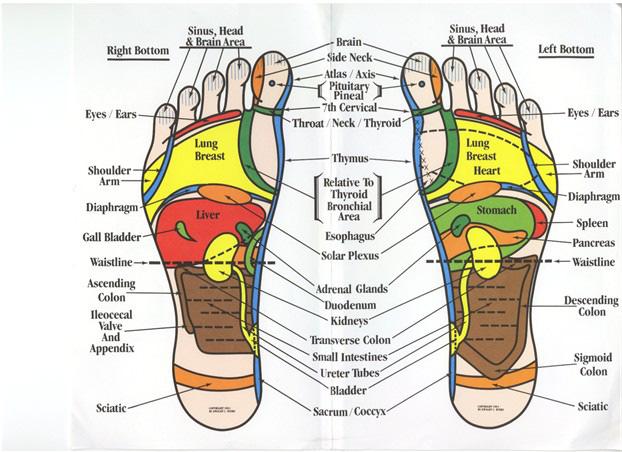
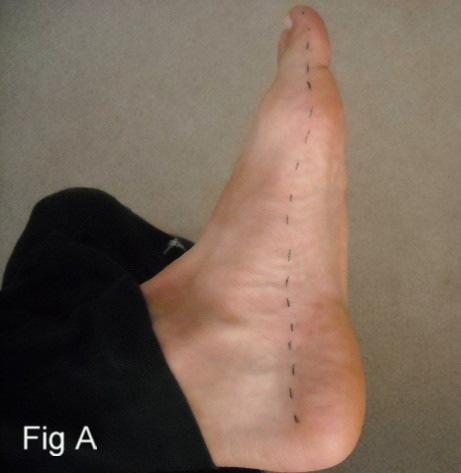
The following illustration represents a foot reflexology chart showing the key points and corresponding target organs of the body.




































